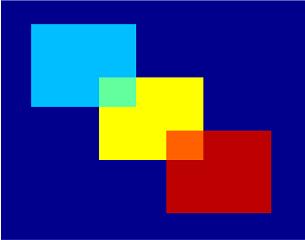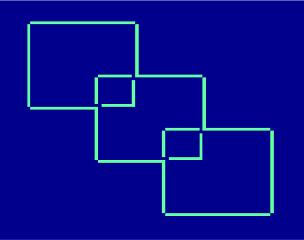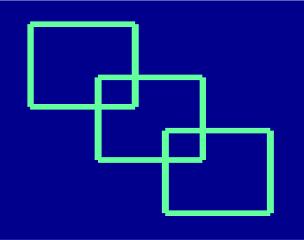Line
detection on an imageThis
experiment explores line
detection (for image
analysis) with Matlab.
|
Since
an image can be expressed with two matrices (one matrix being the color palette
and the other one being the reference
to those colors), we can manipulate pictures
or images by modifying both the map (palette) and the matrix containing
the
values to be displayed. |
It’s recommended
that you first read this
article on RGB images.
This
experiment draws some squares in different colors. These are the coded
details:
%
We choose the 'jet' palette
colormap
jet
%
We define a 90 x 90 matrix, and make it all ones.
%
This means that the 'background' will be the first
% element
found in our palette
r = 90;
c = r;
W =
ones(r, c);
%
Define our colors in very specific areas of the matrix
W(10 :
40, 10 : 40) = 20;
W(30 :
60, 30 : 60) = 40;
W(50 :
80, 50 : 80) = 60;
W(30 :
40, 30 : 40) = 30;
W(50 :
60, 50 : 60) = 50;
%
Display the image and 'turn off' the axes
image(W);
axis off
save
color_squares W
This is the resulting
image or picture:

Now,
we’ll inspect the matrix
pixel-by-pixel (a pixel is a picture element).
If we
find different colors between two consecutive pixels, we’ll write it
down on
another matrix that finally will be shown.
We can
have different approaches to the inpection of consecutive pixels.
We can
do these operations, for example (if i and j represent rows
and columns of the matrix):
(W(i-1,
j) - W(i,j)) + (W(i+1, j) - W(i,j)) +...
(W(i,
j-1) - W(i,j)) + (W(i, j+1) - W(i,j));
or
(W(i-1,
j) - W(i,j))^2 + (W(i+1, j) - W(i,j))^2 +...
(W(i,
j-1) - W(i,j))^2 + (W(i, j+1) - W(i,j))^2;
If the
result is greater than 0 it means that we’ve found different objects
(or edges)
within a picture and we can annotate that information on another
matrix, to be
displayed later.
This is
the full code to the first approach:
load color_squares
[r, c] =
size(W);
W2 =
ones(r, c);
for i = 2 :
r-1
for j = 2 : c-1
cl(i, j) = (W(i-1, j) - W(i,j)) +
(W(i+1, j) - W(i,j)) +...
(W(i, j-1) - W(i,j)) + (W(i,
j+1) - W(i,j));
if cl(i,j) > 0
W2(i,j)
= 30;
end
end
end
image(W2);
axis off
It
produces this image:

We can
change some lines in the code to achieve our second approach:
cl(i, j)
= (W(i-1, j) - W(i,j))^2 + (W(i+1, j) - W(i,j))^2 +...
(W(i, j-1) - W(i,j))^2 + (W(i, j+1)
- W(i,j))^2;
which
produces this picture:

and so
we have performed an edge or line detection from our original image
under
study.
From
'Line Detection' to home
From
'Line Detection' to 'Matlab Programming'

|





